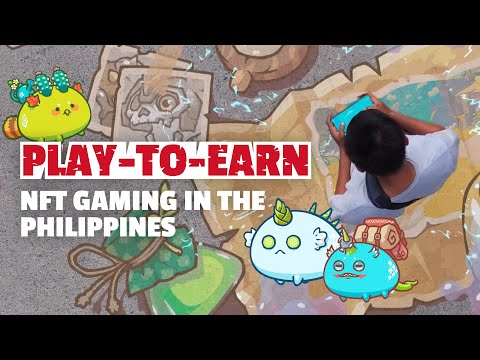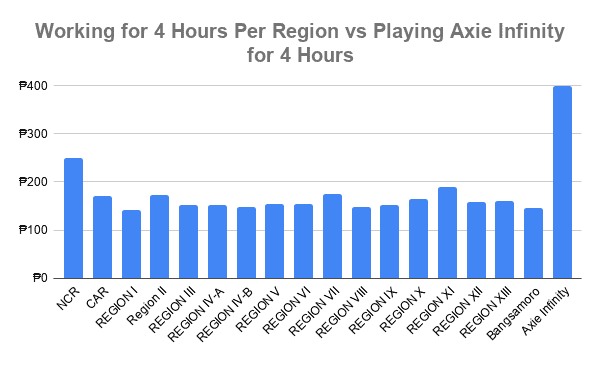This Docu Perfectly Captures the Play-to-Earn Phenomenon in the Philippines
As the reel ended and the credits rolled over, lolo Silverio and lola Vergie became the Axie community’s grandparents. Their wishes became every player’s wish, and the community will do everything in their power to make sure their grandparents’ wishes will come true.

In one rural area in the Philippines, an entire community has earned a living from playing the blockchain game called Axie Infinity. This community is composed of everyday Filipinos — most of them haven’t played a game for a long time and almost all of them haven’t heard of crypto at all. It’s safe to say that most of them are also average gamers. But one thing that ties them together is that all of them have been affected by the pandemic.

Writers, developers, streamers, and many content creators all benefit from the demand for video game-related content. Earnings from games however requires a unique skillset. For example, to be a successful Youtuber, you have to be excellent in your craft and the content you produce. For esports players, knowing the ins and outs of the game is the only way to succeed. Of course, there’s luck too.
But Axie Infinity’s different. You play it like Pokemon. Except this time, you have three Axies and you battle in adventure and player-vs-player modes. You earn the cryptocurrency “SLP” when you win.
The difference is that you can’t exchange your Poke earnings in-game for real cash. But you can with SLP. So imagine a rural town in the Philippines during lockdown. There were no jobs available, which meant difficulty providing food, difficulty getting by. And along came a blockchain game where real money can be earned simply by playing it.
Leah Callon-Butler, columnist for major crypto news publication Coindesk and director of consultancy firm Emfarsis, together with Emfarsis’ principal consultant Nathan Smale travelled to Cabanatuan to meet the very people whose lives have changed because of playing Axie Infinity. Leah (who first reported about it in 2020) interviewed a number of people throughout the documentary. While all of their lives were made difficult by the pandemic, their backgrounds were all different.
Howard was a recent graduate, but with the pandemic situation, there were no jobs available for him, something that his fellow 2020 graduates can attest to. Zabrina just had enough to get by for her family, living from hand to mouth everyday after losing her job. Macky, a tricycle driver, effectively lost his income source since the lockdown meant fewer passengers. Lolo Silverio and Lola Vergie’s only source of income – their sari sari store — was not earning enough — if any at all — at the height of the lockdown.
The documentary successfully conveyed that Axie became a phenomenon because those fortunate enough to discover the game, like Art Art, brought it upon themselves to share it — the opportunity to earn — to their neighbors. Leah narrated how in no time at all, there were 100 people playing Axie Infinity in Art Art’s street alone. This is particularly important since onboarding a player into Axie Infinity is the most difficult step because of it being a blockchain game.
For those who were onboarded, a life-changing event happened — they were able to survive particularly during the hardest moments of the lockdown: Lolo Silverio and Lola Vergie, despite not earning enough from their sari-store, were able to get by from their Axie earnings. They don’t need to go out anymore to look for other work, which is especially dangerous because both of them are at an advanced age and at most risk from the virus. Zabrina was not only able to get by, she was able to pay off her bills and debts too. Howard treated playing Axie as a job instead of waiting for companies that may or may not open anymore. Macky was able to supplement his income to help his parents.
The skeptic may say, this sounds too good to be true. But not until you see the data. When Leah’s article was published, I looked at the data from DOLE to compare how much these players are earning compared to the minimum basic salary in the Philippines. I tracked the earnings of these early players which are more or less the same as of May 5, 2021 because of the increase in the price of SLP ($0.27). Note that this doesn’t count transaction fees and transfer fees.
In a sense, the Filipino tradition of “Bayanihan”, the local custom of working and helping each other may have played an important role in the spread of Axie Infinity in Cabanatuan. This was especially important in the latter half of 2020 and even today, because as the game continues to increase in popularity, coupled with rising cryptocurrency prices, the minimum investment to play it has also increased. (You need to buy three Axies to start playing.) Some more fortunate Axie players started “scholarship programs” — a system wherein the Axie owner rents out their Axies to other people to play the game. Whatever SLP earned is divided between the player and the owner, with which majority of the profits goes to the player. The documentary featured Ken, Spraky, and Pot; the three of them also experienced hardships because of the pandemic but are now offering “scholarships” to their peers, like Howard and Macky above.
Axie scholarship programs were a hit and have onboarded more and more players into the community. It became a viable business model too; Yield Guild Games (YGG) has created one of the largest scholarship programs. Now, it aims to onboard more players into Axie Infinity and other blockchain games with yield opportunities as well. “Filipinos have always been really good at playing games but they’ve never really made anything from them,” said Gabby Dizon, co-founder of YGG who has two decades of experience in the video game development industry in the Philippines. In the past, Gabby noted how the country has been a magnet for outsourced game development. The writer Elias Ahonen, in his profile of Gabby in Cointelegraph Magazine remarked, “But this interaction sat uncomfortably with [Gabby], as he felt that his countrymen were getting the short end of the stick due to receiving no intellectual property rights. The rich countries were trading money for the fruits of Filipino creativity.”
“So now with Play-to-Earn, people have the opportunity to play, which is something that they really like to do, and they have the opportunity to make money from spending their skill and their time in games to make a living and that’s never been possible before,” Gabby said in the documentary.
This April, YGG secured investments from the likes of Delphi Digital and gumi Cryptos. “We love the founding team and NFT is white hot,” gumi Cryptos’ Miko Matsumura told me over email. “Combining DeFi and NFT makes sense to us, and this use case is incredibly exciting and feels like a very natural evolution of open source, which is a more inclusive financial system. Our first investment in the Philippines.”
Miko added that “Play-to-Earn”, which provides equal opportunity for everyone is great especially in countries like the Philippines, which “has a lower cost of living but also a well-educated, smart and talented workforce,” he remarked.
“We feel that YGG and its members will benefit hugely from this new model and that it is very positive for both the guild and the guild members as opposed to traditional gaming which has largely been exploitative.”
Miko Matsumura, Gumi Cryptos
Sky Mavis, the company behind Axie Infinity, also recently secured a series A funding from the likes of Libertus Capital, BlockTower Capital, Sparq, and Coingecko Ventures. The funding would be used to scale Axie Infinity. Shark Tank judge and serial investor Mark Cuban, who also invested in Sky Mavis, attested to the viability of the business model and how “helping others” is an important model too.
The documentary did not go into the specifics of how to actually participate in #PlayToEarn, a conscious decision from Emfarsis to make sure it’s more digestible for the viewers. “We decided to focus on the human stories and hopefully that would inspire people to go seek out more info after watching the film,” Leah Callon-Butler, who narrated the documentary told me.
Still, it should be enough to capture the attention of its immediate audience (crypto enthusiasts and gamers) and the larger public. (BitPinas has articles to get you started with Axie Infinity.) One of the investors mentioned above had an important cameo on the documentary (update: it’s Mark!), and if his words are a foreshadowing, these new rounds of investments to YGG and Axie Infinity would help scale the game and most importantly make onboarding easier.
Leah’s final words in the documentary rings true — Axie Infinity may not be the solution for poverty. However, it’s clear that the game has an impact particularly on the lives of the people interviewed. And lolo and lola’s words are just heart piercing — and I’m sure those are the words of Axie players around the world as well: “Sana hindi mawala tong Axie.” (We hope Axie don’t go away.)
I don’t know your life situation, dear reader, but after watching this pandemic, it is clear that some of us are still more fortunate than others, and the two elders – in particular — really hits me differently, and I remembered my own grandmother who made sure that I get to good school despite the hardships we experienced while I grew up.
As the reel ended and the credits rolled over, lolo Silverio and lola Vergie became the Axie community’s grandparents. Their wishes became every player’s wish, and the community will do everything in their power to make sure their grandparents’ wishes will come true.
Because what lolo and lola yearned for, what they truly wanted, is something to pass on to their grandchildren. Everyone benefits if Axie Infinity continues.
This article is published on BitPinas: This Documentary Perfectly Captures the Play-to-Earn Phenomenon in the Philippines






